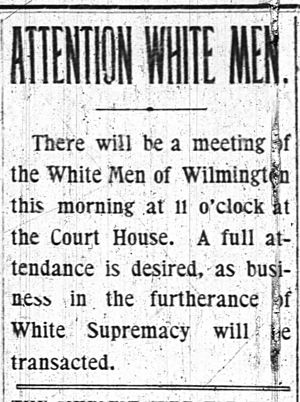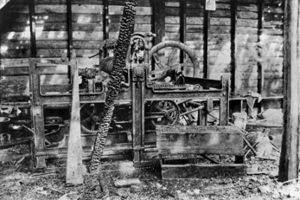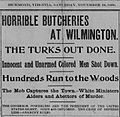Alfred Moore Waddell facts for kids
Quick facts for kids
Alfred Moore Waddell
|
|
|---|---|

Alfred M. Waddell between 1865 and 1880
|
|
| Mayor of Wilmington, North Carolina | |
| In office November 10, 1898 – 1906 |
|
| Preceded by | Silas P. Wright |
| Succeeded by | William E. Springer |
| Member of the U.S. House of Representatives from North Carolina's 3rd district |
|
| In office March 4, 1871 – March 3, 1879 |
|
| Preceded by | Oliver H. Dockery |
| Succeeded by | Daniel L. Russell |
| Personal details | |
| Born | September 16, 1834 Hillsborough, North Carolina, U.S. |
| Died | March 17, 1912 (aged 77) Wilmington, North Carolina, U.S. |
| Spouses | Julia Savage (1857) Ellen Savage (1878) Gabrielle de Rosset (1896) |
| Relations | Hugh Waddell Francis Nash Alfred Moore |
| Children | Elizabeth Savage Alfred M. Waddell Jr. |
| Occupation | politician, lawyer, publisher |
| Known for | led only coup d'état on U.S. soil |
Alfred Moore Waddell (born September 16, 1834 – died March 17, 1912) was an American politician. He was a member of the Democratic Party. He served as a U.S. representative for North Carolina from 1871 to 1879. Later, he became mayor of Wilmington, North Carolina, from 1898 to 1906.
Waddell was a key figure in the Wilmington insurrection of 1898. This event involved a large group of white men who caused violence and destroyed property. They also overthrew the elected local government in Wilmington, North Carolina. After this event, Waddell became mayor of Wilmington. He forced the previous mayor to resign. This event is known as the only successful coup d'état (an unlawful takeover of government) in U.S. history. It led to a time of strict racial segregation and limited voting rights for African-Americans in the Southern states.
Contents
Early Life and School
Alfred Moore Waddell was born in Hillsboro, North Carolina. His father, Hugh Waddell, was a well-known lawyer and a leader in the North Carolina Senate. Alfred was related to important historical figures like General Hugh Waddell and U.S. Supreme Court Justice Alfred Moore.
He went to Bingham's School and Caldwell Institute. Then, he attended the University of North Carolina at Chapel Hill, graduating in 1853. After studying law, he started working as a lawyer in Wilmington in 1855. Even though he was a good lawyer, it is said he did not enjoy the work.
In 1857, he married Julia Savage. They had two children, Elizabeth and Alfred Jr. After Julia passed away, he married her sister, Ellen Savage. Waddell married a third time in 1896, to Gabrielle de Rosset.
Newspaper Work
In July 1860, Waddell bought a major newspaper called the Wilmington Daily Herald. This paper was important in the Cape Fear area. He used it to share his ideas against states leaving the United States. He stopped working in publishing about a year later.
However, he returned in 1881 and 1882 as the editor of the Charlotte Journal. He left publishing for good in 1883 to go back to practicing law. Later, he wrote and published several books. These included a biography of his great-great-grandfather and a historical book about the Cape Fear Region. He also wrote his own life story, "Some Memories of My Life," published in 1908.
Military Service
During the Civil War, Waddell joined the Confederacy in 1861. He started as an adjutant (an assistant officer). He rose to the rank of lieutenant colonel in the Third Cavalry. This group later became known as the Forty-First North Carolina Regiment. His regiment moved around a lot, working as independent cavalry and rangers.
Waddell left the military in 1864 because of poor health.
Political Career
In 1856, Waddell supported the American Party. He was against states leaving the Union before the Civil War. In 1860, he was a delegate (a representative) at the Constitutional Union National Convention.
In 1870, Waddell ran for Congress as a Conservative Democrat. He was elected to the 42nd United States Congress. He was re-elected three times. During his last term, he was chairman of the Committee on Post Offices and Post Roads. He was known as one of the "ablest Southern members" of Congress. He lost his re-election bid in 1878 to Daniel L. Russell.
After his defeat, Waddell stayed active in the Democratic Party. He became a popular speaker and campaigner. He was a delegate at the Democratic National Conventions in 1880 and 1896. In 1898, he was a leader in a statewide campaign focused on white control in Wilmington.
Leading the "White Man's Party" Campaign
Historical Background
After the Civil War, in 1868, North Carolina approved the 14th Amendment. This led to a period called Reconstruction. During this time, the state government was controlled by the Republican Party. Many Democrats were unhappy with these changes. They wanted to return to the way things were before the war.
Democrats began to change laws and gain control of the state's courts and local governments. They made changes to the state constitution. These changes included lowering the number of judges and putting local governments under state control. They also made public schools separate for different races and outlawed interracial relationships. These actions made Conservative Democrats popular with many white Americans. However, their power was mostly in the western part of the state, where there were fewer African-Americans.
In the eastern part of North Carolina, poor white farmers were upset with big banks and railroad companies. They joined with African-American Republicans who shared their struggles. Together, they formed an alliance called the Fusion Coalition. This group supported self-governance, free public education, and equal voting rights for African-American men.
In 1894 and 1896, the Fusion Party won many state offices, including the governorship. This shift in power worried white Democrats. They saw some weaknesses in the Fusion alliance in 1898.
Becoming a Leader
The Democratic Party leader, Furnifold Simmons, planned their campaign for 1898. He decided to focus the campaign on the idea of white control.
Simmons created a group of talented speakers to spread this message across the state. Alfred Moore Waddell was one of these speakers. He was known as a very skilled orator. Waddell joined the Democrats in their campaign to "redeem North Carolina from Negro domination."
Before the November election in 1898, some white men started to leave the Fusion coalition. This gave the Democrats, who now called themselves "The white man's party," an opportunity.
In Wilmington, Waddell spoke to a large crowd. He was on stage with 50 important white men from the city. Waddell stated that white control was the most important issue for white men. He also suggested punishment for those who did not support this idea. Waddell was especially good at using his speeches to stir up strong feelings. His powerful words made Wilmington a focus for white men across the state. Soon after his speech, groups like The Red Shirts began riding through the state, causing fear among African-American citizens and voters.
Leading the Committee
After Waddell's speech, a group called the "Secret Nine" chose him to lead a "Committee of Twenty-Five." This committee was in charge of carrying out the plans in "The White Declaration of Independence." This document, written by the Secret Nine, called for limiting voting rights for African-Americans. It also aimed to overthrow the newly elected government, which included both white and African-American officials.
With his new role, Waddell gave speeches across the state to unite white men. For example, he spoke to a crowd of 8,000 people in Goldsboro.
In the Wilmington election, Democrats won by 6,000 votes. This was a big change from the Fusion Party's win just two years before. However, the Fusion Party still held power in Wilmington. This city had the largest concentration of African-American wealth and businesses in North Carolina.
On November 9, Waddell went to the county courthouse. There, he revealed The White Declaration of Independence. He told a crowd of 600 people that the U.S. Constitution "did not anticipate the enfranchisement of an ignorant population of African origin." He also said that white men in New Hanover County would "never again" allow African-Americans to participate in politics. He demanded that African-Americans "stop antagonizing our interests" and that the city "give to white men a large part of the employment heretofore given to Negroes."
The Wilmington Unlawful Takeover
The next morning, November 10th, Waddell led a well-planned government overthrow. This happened at the same time as other violent events across the state.
At 8:15 AM, Waddell went with about 2,000 white men to Wilmington's armory. They armed themselves with rifles and a Gatling gun. Then, they went to the office of "The Daily Record" newspaper. They broke into the building, damaged the printing press, and set the building on fire. Other African-American newspapers across the state were also destroyed. African-Americans and white Republicans were also blocked from entering city centers.
After the fire, white groups went into African-American neighborhoods in Wilmington. They destroyed businesses and property. They also attacked African-American residents.
As the violence grew, Waddell led a group to the Republican Mayor, Silas P. Wright. Waddell forced Mayor Wright, the city council, and the police chief to resign at gunpoint. Around 4:00 PM, Waddell was declared Wilmington's mayor. He stayed in this position until 1906.
It is believed that by the end of that day, Waddell's actions led to the deaths of many African-American people. About 20 more were forced to leave the city.
Calling it a "Race Riot"
On November 26, 1898, Collier's Weekly published an article by Waddell. It was titled, "The Story of The Wilmington, North Carolina, Race Riots."
Even though Waddell had made extreme statements, he presented himself in the article as a reluctant leader. He claimed he was "called upon" to lead under difficult conditions. He described the white group as peaceful citizens who only wanted to restore order.
Waddell's story, and his use of the term "race riot," ignored that the overthrow was a carefully planned event. His account made it seem like the event "spontaneously happened." This helped shape how the event was remembered in history. It also set a pattern for how the term "race riot" was used later.
Death
Alfred Moore Waddell died in Wilmington in 1912.
Images for kids










